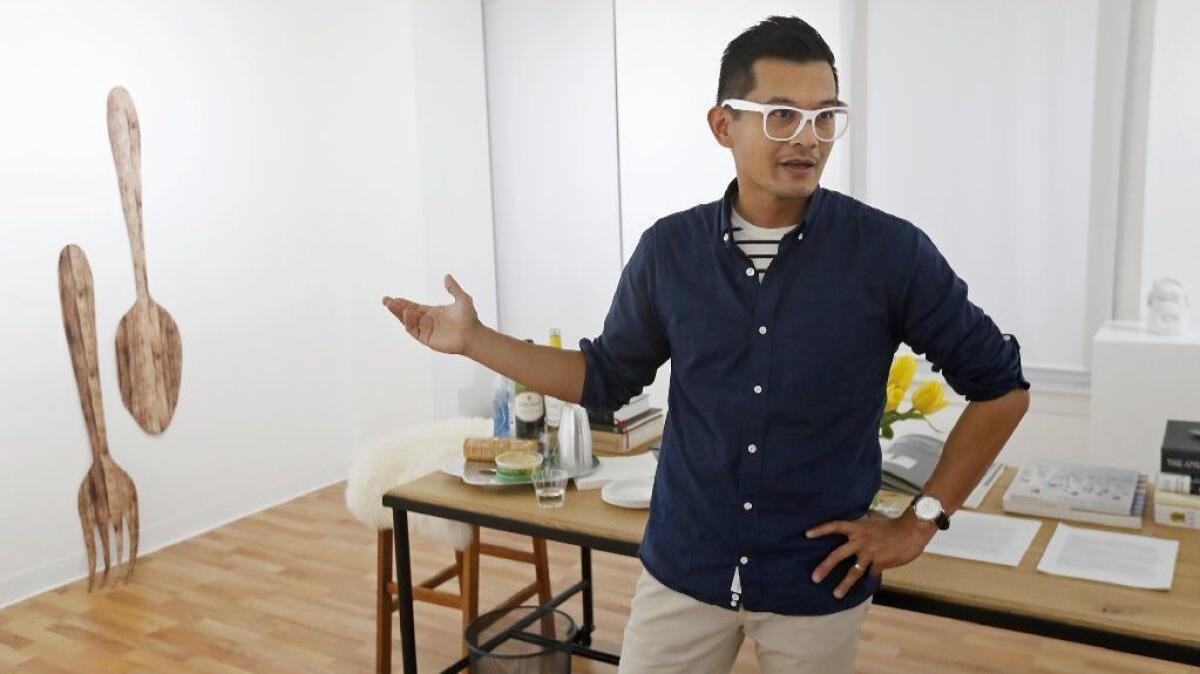‘Super Sarap’ merges art and food while examining the Filipino American experience

- Share via
Mik Gaspay calls his mother May Gaspay a “secret artist.” An immigrant from the Philippines, she worked as a nurse for many years before retiring and opening an at-home day care.
But she was his first art teacher, and she now uses his childhood bedroom to house her 10-foot-wide quilting machine and collection of fabrics.
“Spoon and Fork,” which is currently on display at Santa Ana’s Gallery 6/67 as part of the “Super Sarap” exhibit, is Mik Gaspay’s first official collaboration with his mom. Though he often uses found objects to explore questions of capitalism, migration and identity in his art, this is the first time he’s working with fabrics.
Together, Mik and May Gaspay crafted a large-scale quilt version of the wooden spoon and fork that is familiar to many Filipinos.
“In Filipino households, at least from my mother’s generation and my generation, wooden spoons and forks were pretty common,” Gaspay said. “But no one knows the exact history of why, when, or who started it … It’s a mysterious motif that was never explained. It was just there.”
“Super Sarap,” which was curated by Patricia Cariño Valdez, is an exhibit that explores Filipino cooking beyond the way it’s been “trending” in America, explained Erica Wall, the founder and director of Gallery 6/67.
It began with artist Jeanne F. Jalandoni, who used soft and plush materials to evoke “comfort” food — quilted blankets displaying the ingredients to make lumpia, beef empanadas, and leche flan, as well as rice cooker plushies.

From there, Valdez added a neon “UBE” sign and super close-up photography of Filipino ice cream, both made by O.M. France, as well as Gaspay’s work.
Just like the varied ways the wooden spoons and forks are displayed in homes, “Spoon and Fork” is meant to be hung in any configuration, Gaspay explained. In Gallery 6/67, the spoon and fork are hanging vertical on the wall, with the tips of the fork grazing the floor. But in Mik’s own studio, he hung them from the ceiling on a motor, where it rotated in a circle, held up by thin fishing lines that made them look like they’re floating in midair.
“I like it when artwork is not so precious,” he said, as he encouraged people to feel the fabric. “You can still craft them like jewels, but you don’t have to treat them like jewels necessarily … It’s a quilt, so you could wash it, and it’d probably look cooler as it gets worn and used and you live with it.”
Gallery 6/67, which just had its first exhibit in February, also aims to make art more accessible to folks that might otherwise be intimidated by a typical museum experience.
“From the time you’re a kid on a second-grade field trip to a museum, you’re told to be quiet, stand still and listen,” Wall said. “We want people to be comfortable to ask questions and have conversations … There’s a place for everyone.”
Wall has worked in museums for most of her career. Understanding that it often takes years for an artist to be invited to exhibit at these prestigious institutions, she wanted to start her own space to help underrepresented artists work, exhibit and sell their pieces as they’re building their careers. She knows it’s a difficult path to even get a shot at being included in the canon of art history that she — as a child of a Filipina American mother and an African American father — values, but rarely sees herself represented in.

The words “super sarap” combine English and Tagalog to encompass what Wall calls “the liminial space” that many Filipino Americans — and other immigrants — exist in when they are straddling two cultures. Once she realized there were two Filipino chefs running restaurants in the downtown Santa Ana arts district within walking distance of the gallery — chef Ross Pangilinan at Mix Mix Kitchen Bar and chef Ryan Garlitos at Irenia Restaurant — Wall organized culinary events as part of the exhibit.
Chef Pangilinan, who just opened his second restaurant Terrace by Mix Mix in South Coast Plaza in September, relates to the pressures and expectations of being “in between.”
“Even some Filipinos come in here and say, ‘Oh, you’re not a Filipino restaurant,’ ” he said, of his global cuisine. “But I was born in the States, I trained in French and Italian restaurants, and I grew up eating whatever every other American grew up eating — in addition to Filipino food.”
On Nov. 15, Pangilinan created special Filipino menu for the first “Super Sarap” dinner, which also celebrated Mix Mix’s second anniversary. It included kinilaw (Filipino ceviche), ribeye and a fish course inspired by pinakbet, an indigenous Filipino dish from the northern regions of the Philippines.
The second “Super Sarap” culinary event at Irenia Restaurant, which is named after chef Garlito’s grandmother, takes place on Dec. 9. For more information, go to gallery667.com.
More to Read
The biggest entertainment stories
Get our big stories about Hollywood, film, television, music, arts, culture and more right in your inbox as soon as they publish.
You may occasionally receive promotional content from the Los Angeles Times.











